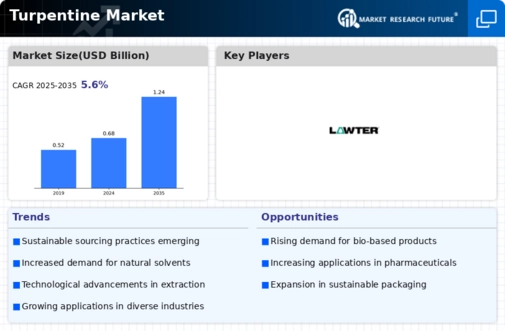Market Share
Turpentine Market Share Analysis
Market share positioning strategies are pivotal in shaping the competitive landscape of the Turpentine Market. With diverse applications spanning from industrial solvents to pharmaceuticals and fragrances, companies vie for a larger slice of the market through strategic maneuvers. Differentiation stands as a cornerstone strategy, where companies accentuate unique qualities of their turpentine products. This might involve emphasizing purity, sustainability, or specialized formulations tailored to specific industries. By showcasing these distinguishing factors, companies can attract customers who prioritize certain attributes in their turpentine purchases.
Pricing strategies also wield significant influence in market share positioning. Some companies opt for penetration pricing, setting lower prices to swiftly capture market share. This approach can appeal to cost-conscious buyers and enable companies to gain traction in competitive markets. Conversely, premium pricing strategies target customers willing to pay more for superior quality or additional benefits. By positioning their turpentine products as high-value offerings, companies can carve out a niche and attract discerning clientele.
Moreover, distribution channels play a crucial role in market share positioning within the turpentine industry. Companies may focus on expanding their distribution networks to broaden their market reach. This could entail partnering with wholesalers, retailers, or online platforms to enhance accessibility and availability of their turpentine products. Ensuring seamless access to their offerings enables companies to compete effectively against rivals with similar products.
Marketing and branding strategies also factor heavily in market share positioning efforts. Companies invest in promotional activities, advertising campaigns, and brand-building initiatives to bolster awareness and recognition. Establishing a strong brand identity can foster customer loyalty and command a larger market share. Emphasizing factors such as reliability, eco-friendliness, or versatility in marketing endeavors can sway purchasing decisions and bolster market share growth.
Innovation emerges as a key driver of market share positioning in the turpentine industry. Companies that invest in research and development to introduce novel products or technologies can gain a competitive edge. Whether it's developing eco-friendly extraction methods or creating specialized formulations for niche applications, innovation can differentiate companies and attract customers seeking cutting-edge solutions.
Strategic partnerships and collaborations also play a pivotal role in market share positioning strategies. By forging alliances with complementary businesses or industry players, companies can leverage synergies to their advantage. This could involve collaborations with manufacturers of related products or partnerships with distributors to expand market reach. Strategic alliances enable companies to access new markets, technologies, and distribution channels, bolstering their position in the turpentine market.


 Source: Secondary Research, Primary Research, Market Research Future Database and Analyst Review
Source: Secondary Research, Primary Research, Market Research Future Database and Analyst Review

Leave a Comment